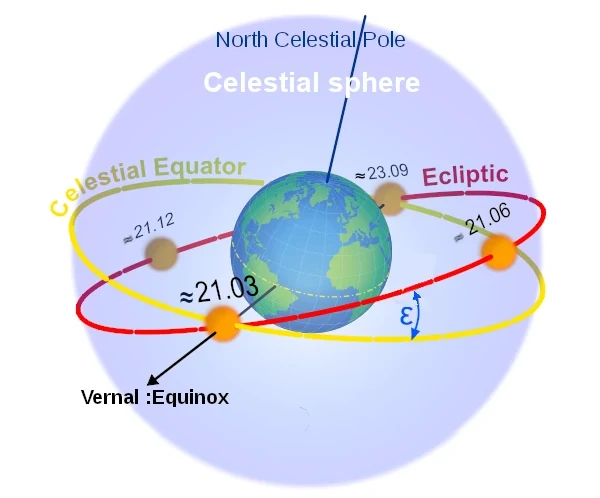
Astronomical seasons never start exactly on the same calendar date. Thus, in the northern hemisphere, spring can begin on March 20 or 21, summer on June 20 or 21, autumn on September 22 or 23, and winter on December 21 or 22. This variability is not arbitrary but results from three main causes: the actual duration of the tropical year, leap years, and the precession of the equinoxes.
N.B.:
The tropical year is the time it takes for the Earth to return to the same apparent position relative to the Sun, that is, from one spring equinox to the next. It lasts about 365.2422 days, or about 5 hours, 48 minutes, and 46 seconds longer than a 365-day civil year. This duration, slightly shorter than the sidereal year (\(365.2564\) days), is due to the precession of the equinoxes, which slowly shifts seasonal markers over time.
N.B.:
The sidereal year corresponds to the time it takes for the Earth to complete a full revolution around the Sun relative to the fixed stars, about 365.2564 days. It is slightly longer than the tropical year (365.2422 days) due to the precession of the equinoxes, which causes the seasons to drift backward in the calendar. The sidereal year is mainly used in astronomy to track the position of stars in the sky over the years.
The tropical year, which measures the time between two successive spring equinoxes, actually lasts about \(365.2422\) days. However, our civil calendar is based on years of 365 or 366 days. This difference of approximately \(0.2422\) days (or about 5 hours and 49 minutes) accumulates year after year, gradually shifting the equinoxes and solstices in the calendar.
To compensate for this shift, the Gregorian calendar introduces a leap year every four years, with exceptions (century years not divisible by 400 are not leap years). This mechanism approximates the duration of the tropical year to \(365.2425\) days, reducing the average error to about 26 seconds per year. Despite this, the precise moment of the seasons continues to drift slightly from year to year.
The Earth does not rotate in space like a perfectly stable top. Its axis of rotation describes a slow cone, a phenomenon called the precession of the equinoxes. This movement causes a gradual shift of the equinoxes over time (about 20 minutes per century), modifying the seasonal dates over the very long term. Added to this are more subtle effects such as the variation in the eccentricity of the Earth's orbit and nutations, which make the dynamics more complex.
| Year | Spring | Summer | Autumn | Winter |
|---|---|---|---|---|
| 2020 | March 20 03:50 | June 20 21:44 | September 22 13:31 | December 21 10:02 |
| 2021 | March 20 09:37 | June 21 03:32 | September 22 19:21 | December 21 15:59 |
| 2022 | March 20 15:33 | June 21 09:14 | September 23 01:04 | December 21 21:48 |
| 2023 | March 20 21:24 | June 21 14:58 | September 23 06:50 | December 22 03:27 |
| 2024 | March 20 03:06 | June 20 20:51 | September 22 12:44 | December 21 09:20 |
| 2025 | March 20 09:01 | June 21 02:42 | September 22 18:19 | December 21 15:03 |
| 2026 | March 20 14:46 | June 21 08:25 | September 23 00:05 | December 21 20:50 |
| 2027 | March 20 20:24 | June 21 14:11 | September 23 05:54 | December 22 02:41 |
| 2028 | March 20 02:17 | June 20 19:56 | September 22 11:44 | December 21 08:19 |
| 2029 | March 20 08:02 | June 21 01:50 | September 22 17:27 | December 21 14:15 |
| 2030 | March 20 13:51 | June 21 07:32 | September 22 23:26 | December 21 20:12 |
Source: IMCCE – Institute of Celestial Mechanics and Ephemeris Calculation, Time and Date – Seasons.